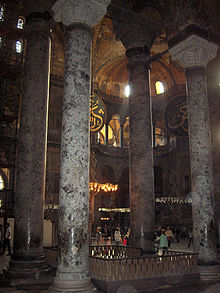
Back Oficalcita AN Ophicalcit German Ophicalcite French Ofikalcit Hungarian Verd antik ID Oficalce Italian Verde antico NN Ofikalcyt Polish Verd antique Portuguese Офикальцит Russian



Verd antique (obsolete French, from Italian, verde antico, "ancient green"), also called verde antique, marmor thessalicum, or Ophite, is a serpentinite breccia[1] popular since ancient times as a decorative facing stone. It is a dark, dull green, white-mottled (or white-veined) serpentine, mixed with calcite, dolomite, or magnesite, which takes a high polish.[2] The term verd antique has been documented in English texts as early as 1745.[citation needed]
It is sometimes classed, erroneously, as a variety of marble ("Thessalian marble", "serpentine marble", "Moriah stone", etc.). It has also been called and marketed as "ophicalcite" or "ophite".[3]
Non-brecciated varieties of a very similar serpentinite, sometimes also called "verd antique", have been quarried at Victorville, California;[4] Cardiff, Maryland;[5] Holly Springs, Georgia;[6] and Rochester in Addison County, Vermont.[7]
- ^ Hager, Albert D. and Billings, E. Report on the Economical Geology, Physical Geography and Scenery of Vermont. Claremont, N.H.: Claremont Manufacturing Co., 1862, p. 50.
- ^ Schumann, Walter. Gemstones of the World. Rev. and exp. 4th ed. New York: Sterling Publishing Company, 2009, p. 218.
- ^ Dedyne, Roger and Quintens, Ivo. Tables of Gemstone Identification. Gent, Belgium: Glirico, 2007, p. 73.
- ^ MacFall, Russell P. Gem Hunter's Guide. New York: Thomas Y. Crowell Company, 1975, p. 140.
- ^ "Notes From the Stone Fields." Stone. 35:1 (January 1914), p. 50.
- ^ Stone, Ralph W., Sanford, Samuel. Useful Minerals of the United States. United States: U.S. Government Printing Office. 1914, p.63
- ^ Hitchcock, Edward. Report on the Geology of Vermont: Descriptive, Theoretical, Economical, and Scenographical. Proctorsville, Vt.: Vermont State Legislature, 1861, p. 534.